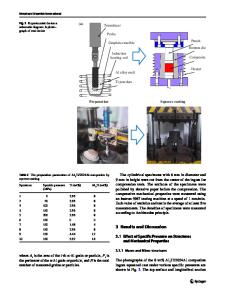A comparison of the mechanical properties and microstructures of intermetallic matrix composites fabricated by two diffe
- PDF / 2,859,339 Bytes
- 13 Pages / 598 x 778 pts Page_size
- 42 Downloads / 361 Views
I.
INTRODUCTION
THE tensile properties of SCS-6 SiC fiber-reinforced Ti-24Al-1 INb (at. pct) have been measured by a number of investigators. [1-7l The SiC/Ti-24A1-11Nb composites studied in these investigations have been fabricated by different techniques such as the powder-cloth, t~'2'31 foilfiber-foil,/1'4"5] low-pressure plasma spray (LPPS), ll,5'6] and wire-arc spray tt,7] methods. Unidirectional SiC/Ti24A1-11Nb composites tend to exhibit a large amount of scatter in the longitudinal tensile properties at ambient temperature. For example, the longitudinal ultimate tensile strength (UTS) at ambient temperature has been reported t~] to range from about 840 to 1500 MPa in powder-cloth composites and from about 900 to 2010 MPa in low-pressure plasma-sprayed composites, when random fiber lots were used during fabrication. A similar range in properties has been observed in composites fabricated by other techniques. Because of the wide range in these composite strengths, it has been difficult to determine if a particular fabrication method produces composites with improved mechanical properties. In fact, direct composite property comparisons between different studies in the literature can sometimes lead to erroneous conclusions, since fabrication methods are being optimized continually. Another complication that hampers these cross comparisons is that the starting fiber and matrix materials in these REBECCA A. MacKAY, Senior Materials Scientist, and SUSAN L. DRAPER, Materials Research Engineer, are with the NASA-Lewis R e s e a r c h C e n t e r , C l e v e l a n d , OH. ANN M. RITTER, S t a f f Metallurgist, and PAUL A. SIEMERS, Staff Chemist, are with General Electric Company, Corporate Research and Development, Schenectady, NY. Manuscript submitted October 6, 1993. METALLURGICAL AND MATERIALS TRANSACTIONS A
studies are from different lots. Thus, differences in composite properties between studies cannot necessarily be attributed to different fabrication methods but may actually be the result of differences in starting fiber and/or matrix quality. Draper eta/. t2l have shown that when the variability in as-received fiber strength is reduced in a given SiC/Ti-24Al-llNb composite panel, the scatter in composite strength is reduced, since the longitudinal strength of unidirectional composites is controlled primarily by the fibers. Thus, the purpose of the present study was to compare the longitudinal tensile strengths of unidirectional SCS-6 SiC/Ti-24Al-llNb composites that have been fabricated by two different methods, the powder-cloth technique and the LPPS technique. The powder-cloth technique has been used extensively at the NASA-Lewis Research Center and has been optimized for SiC/Ti24A1-11Nb. The LPPS process has been developed and optimized for SiC/Ti-24A1-11Nb at the General Electric Corporate Research and Development Center. It is believed that this is the first study of its kind to make such a comparison between fabrication methods in a carefully controlled series of experiments. Both processes used matri
Data Loading...











